Abstract
As part of an ongoing study on all limb reduction defects occurring among 1,213,913 consecutive live births in the province of British Columbia, Canada, during 1952-1984, cases with documented maternal drug exposure and chronic maternal diseases were analyzed separately. This population-based study was made possible through the existence of an ongoing Health Surveillance Registry, which documents all infants born with congenital, genetic, or chronically handicapping conditions in the province of British Columbia. Strict rules of confidentiality are obeyed. For this part of the analysis of limb reduction defects, cases with documented maternal illness, drug abuse, and exposure to environmental hazards early in pregnancy were analyzed as a separate group to identify specific, recurring patterns of anomalies. A total of 51 cases with possibly related maternal factors were identified. Among them were five cases with maternal epilepsy, four cases with documented maternal diabetes, and three cases with uterine anomalies. Three infants, all born in 1962, had documented thalidomide exposure. It is rarely possible to identify particular teratogenic factors or specific maternal factors as etiologically related to the pattern of limb reduction defects or a spectrum of congenital malformations. Exposure to environmental factors during pregnancy is not reliably registered and can thus only occasionally be ascertained in retrospective studies. This means that very large numbers of cases and cross-referencing to other family members are required to assess whether a potential teratogen is related to limb defects or not.
Full text
PDF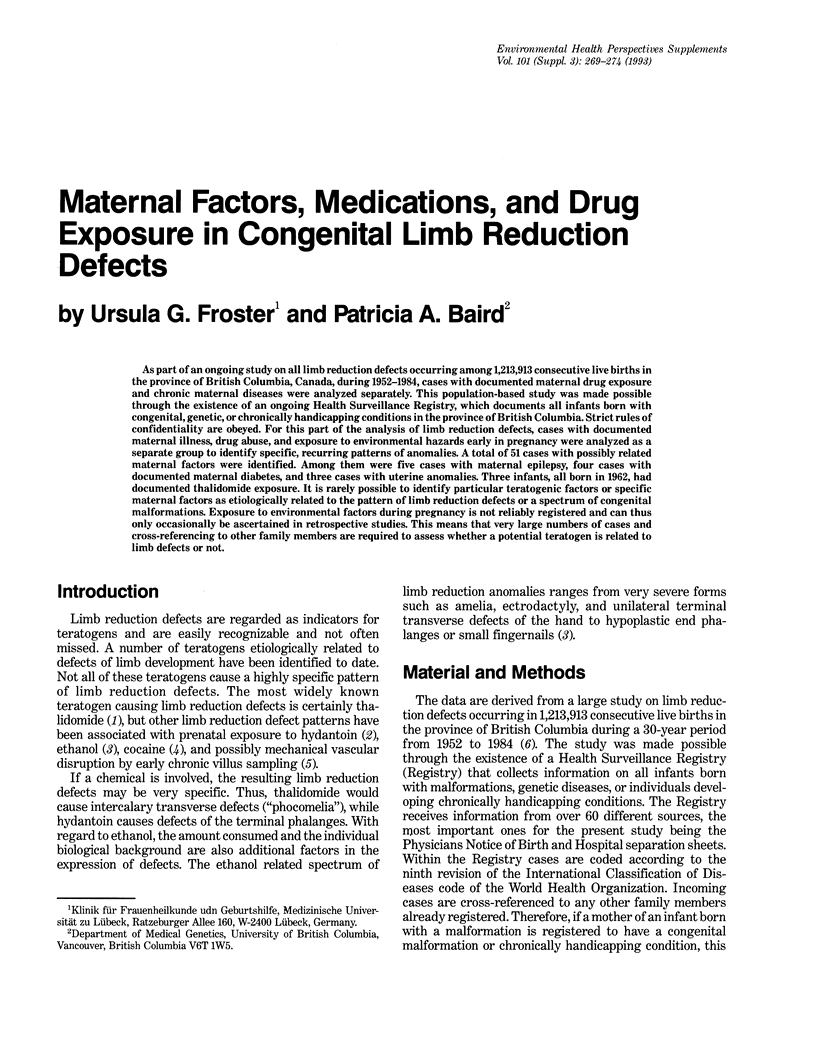
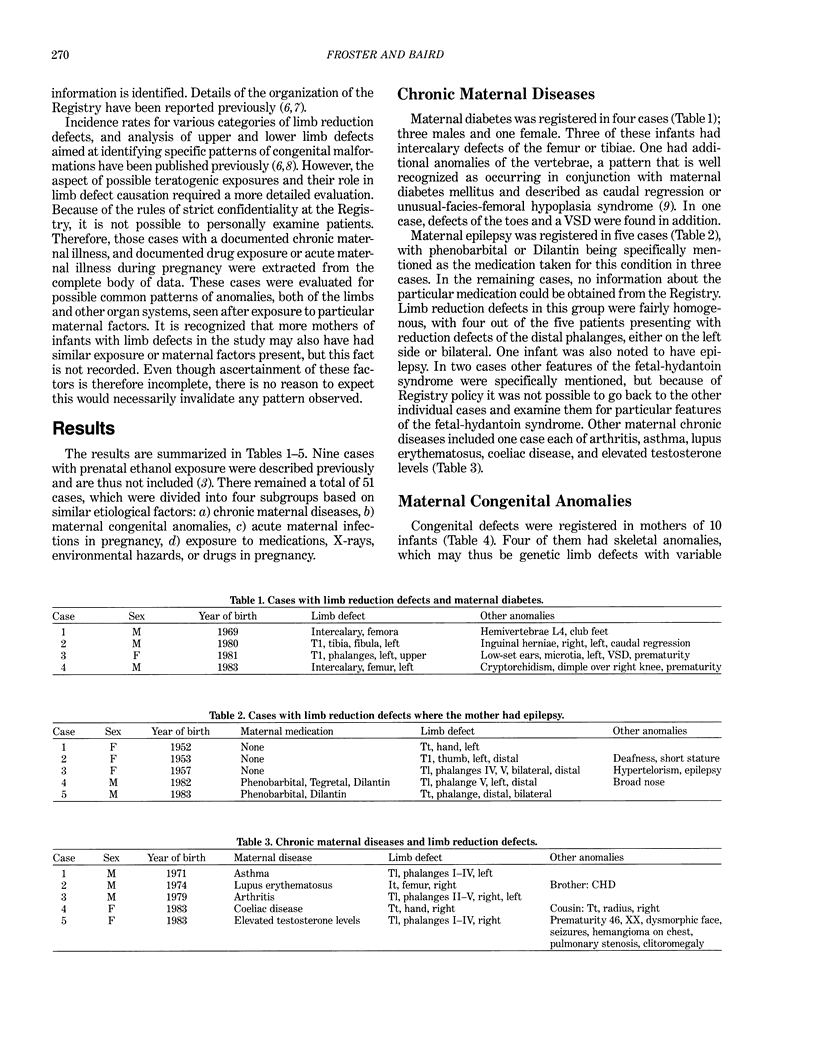
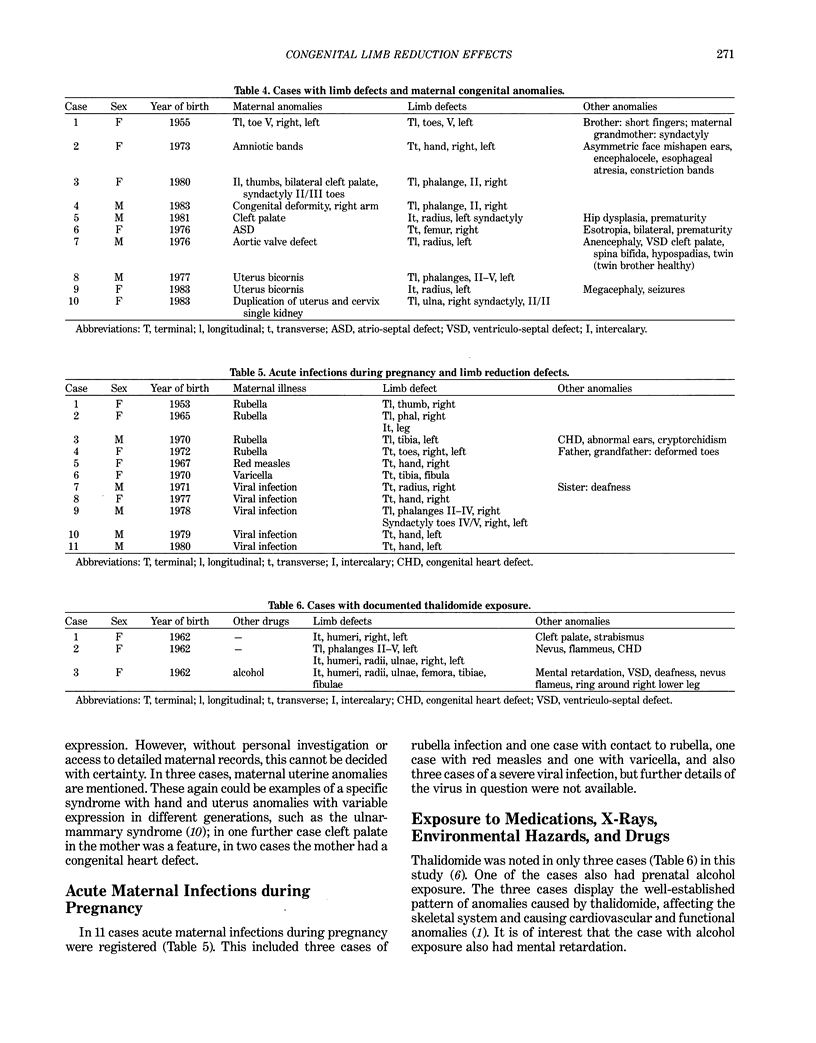
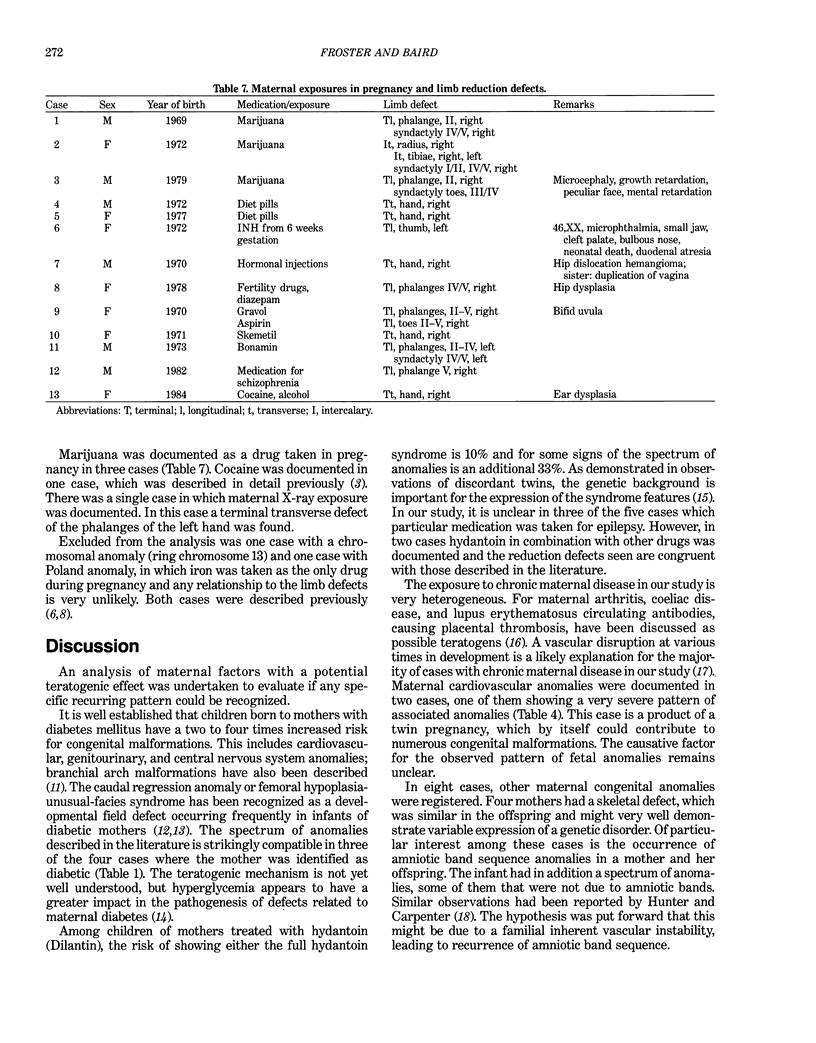
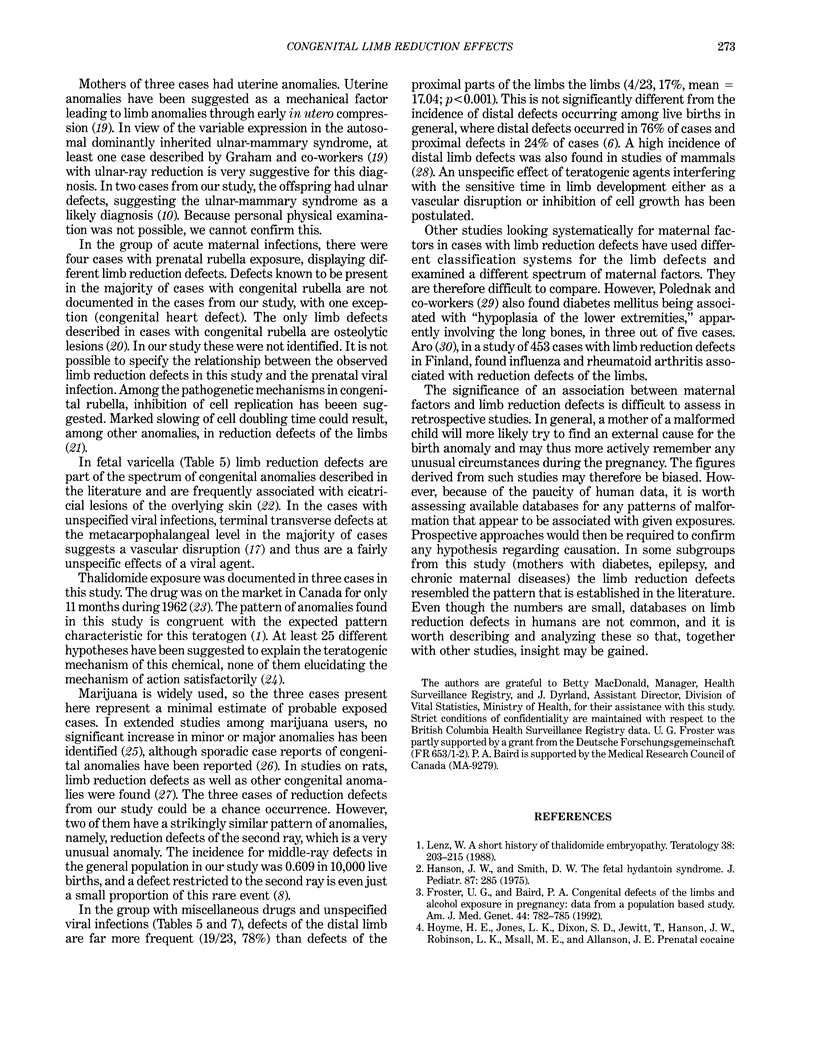
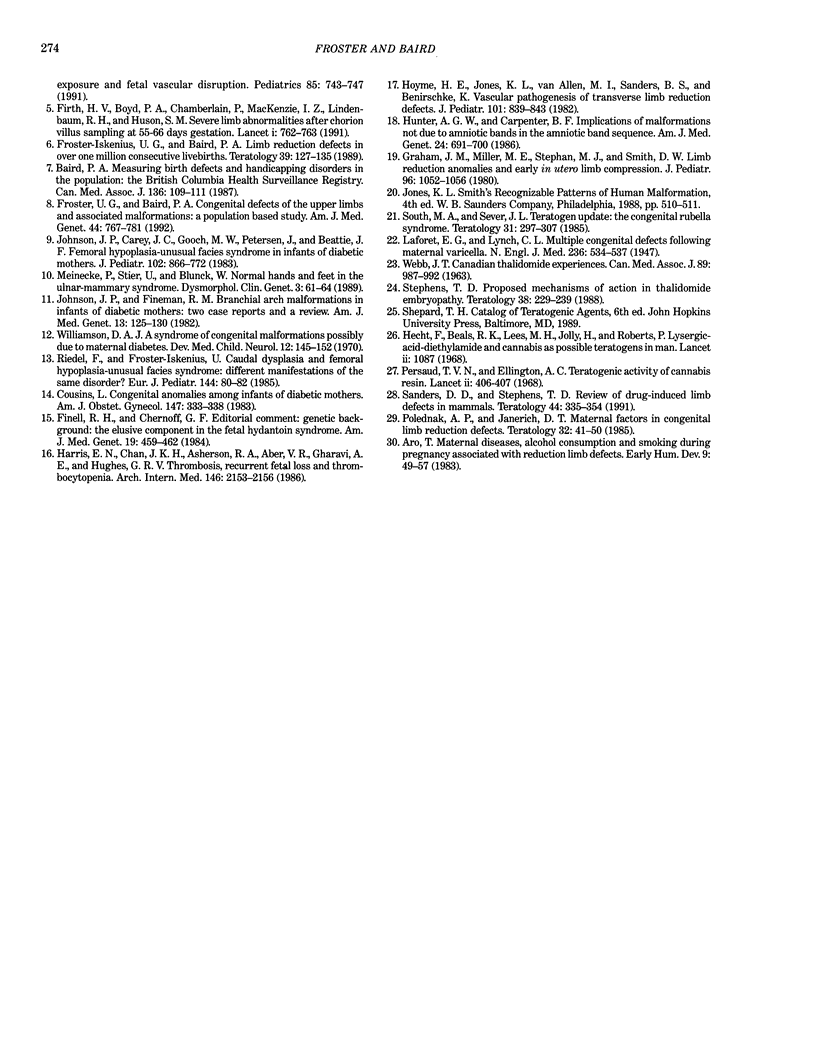
Selected References
These references are in PubMed. This may not be the complete list of references from this article.
- Aro T. Maternal diseases, alcohol consumption and smoking during pregnancy associated with reduction limb defects. Early Hum Dev. 1983 Dec;9(1):49–57. doi: 10.1016/0378-3782(83)90101-9. [DOI] [PubMed] [Google Scholar]
- Baird P. A. Measuring birth defects and handicapping disorders in the population: the British Columbia Health Surveillance Registry. CMAJ. 1987 Jan 15;136(2):109–111. [PMC free article] [PubMed] [Google Scholar]
- Cousins L. Congenital anomalies among infants of diabetic mothers. Etiology, prevention, prenatal diagnosis. Am J Obstet Gynecol. 1983 Oct 1;147(3):333–338. doi: 10.1016/0002-9378(83)91122-5. [DOI] [PubMed] [Google Scholar]
- Finnell R. H., Chernoff G. F. Genetic background: the elusive component in the fetal hydantoin syndrome. Am J Med Genet. 1984 Nov;19(3):459–462. doi: 10.1002/ajmg.1320190306. [DOI] [PubMed] [Google Scholar]
- Firth H. V., Boyd P. A., Chamberlain P., MacKenzie I. Z., Lindenbaum R. H., Huson S. M. Severe limb abnormalities after chorion villus sampling at 56-66 days' gestation. Lancet. 1991 Mar 30;337(8744):762–763. doi: 10.1016/0140-6736(91)91374-4. [DOI] [PubMed] [Google Scholar]
- Froster-Iskenius U. G., Baird P. A. Limb reduction defects in over one million consecutive livebirths. Teratology. 1989 Feb;39(2):127–135. doi: 10.1002/tera.1420390205. [DOI] [PubMed] [Google Scholar]
- Froster U. G., Baird P. A. Congenital defects of the limbs and alcohol exposure in pregnancy: data from a population based study. Am J Med Genet. 1992 Dec 1;44(6):782–785. doi: 10.1002/ajmg.1320440612. [DOI] [PubMed] [Google Scholar]
- Froster U. G., Baird P. A. Upper limb deficiencies and associated malformations: a population-based study. Am J Med Genet. 1992 Dec 1;44(6):767–781. doi: 10.1002/ajmg.1320440611. [DOI] [PubMed] [Google Scholar]
- Graham J. M., Miller M. E., Stephan M. J., Smith D. W. Limb reduction anomalies and early in utero limb compression. J Pediatr. 1980 Jun;96(6):1052–1056. doi: 10.1016/s0022-3476(80)80640-8. [DOI] [PubMed] [Google Scholar]
- Hanson J. W., Smith D. W. The fetal hydantoin syndrome. J Pediatr. 1975 Aug;87(2):285–290. doi: 10.1016/s0022-3476(75)80604-4. [DOI] [PubMed] [Google Scholar]
- Harris E. N., Chan J. K., Asherson R. A., Aber V. R., Gharavi A. E., Hughes G. R. Thrombosis, recurrent fetal loss, and thrombocytopenia. Predictive value of the anticardiolipin antibody test. Arch Intern Med. 1986 Nov;146(11):2153–2156. [PubMed] [Google Scholar]
- Hoyme H. E., Jones K. L., Dixon S. D., Jewett T., Hanson J. W., Robinson L. K., Msall M. E., Allanson J. E. Prenatal cocaine exposure and fetal vascular disruption. Pediatrics. 1990 May;85(5):743–747. [PubMed] [Google Scholar]
- Hoyme H. E., Jones K. L., Van Allen M. I., Saunders B. S., Benirschke K. Vascular pathogenesis of transverse limb reduction defects. J Pediatr. 1982 Nov;101(5):839–843. doi: 10.1016/s0022-3476(82)80343-0. [DOI] [PubMed] [Google Scholar]
- Hunter A. G., Carpenter B. F. Implications of malformations not due to amniotic bands in the amniotic band sequence. Am J Med Genet. 1986 Aug;24(4):691–700. doi: 10.1002/ajmg.1320240414. [DOI] [PubMed] [Google Scholar]
- Johnson J. P., Carey J. C., Gooch W. M., 3rd, Petersen J., Beattie J. F. Femoral hypoplasia-unusual facies syndrome in infants of diabetic mothers. J Pediatr. 1983 Jun;102(6):866–872. doi: 10.1016/s0022-3476(83)80013-4. [DOI] [PubMed] [Google Scholar]
- Johnson J. P., Fineman R. M. Branchial arch malformations in infants of diabetic mothers: two case reports and a review. Am J Med Genet. 1982 Oct;13(2):125–130. doi: 10.1002/ajmg.1320130204. [DOI] [PubMed] [Google Scholar]
- Lenz W. A short history of thalidomide embryopathy. Teratology. 1988 Sep;38(3):203–215. doi: 10.1002/tera.1420380303. [DOI] [PubMed] [Google Scholar]
- Persaud T. V., Ellington A. C. Teratogenic activity of cannabis resin. Lancet. 1968 Aug 17;2(7564):406–407. doi: 10.1016/s0140-6736(68)90626-0. [DOI] [PubMed] [Google Scholar]
- Polednak A. P., Janerich D. T. Maternal factors in congenital limb-reduction defects. Teratology. 1985 Aug;32(1):41–50. doi: 10.1002/tera.1420320107. [DOI] [PubMed] [Google Scholar]
- Riedel F., Froster-Iskenius U. Caudal dysplasia and femoral hypoplasia-unusual facies syndrome: different manifestations of the same disorder? Eur J Pediatr. 1985 May;144(1):80–82. doi: 10.1007/BF00491933. [DOI] [PubMed] [Google Scholar]
- Sanders D. D., Stephens T. D. Review of drug-induced limb defects in mammals. Teratology. 1991 Sep;44(3):335–354. doi: 10.1002/tera.1420440310. [DOI] [PubMed] [Google Scholar]
- South M. A., Sever J. L. Teratogen update: the congenital rubella syndrome. Teratology. 1985 Apr;31(2):297–307. doi: 10.1002/tera.1420310216. [DOI] [PubMed] [Google Scholar]
- Stephens T. D. Proposed mechanisms of action in thalidomide embryopathy. Teratology. 1988 Sep;38(3):229–239. doi: 10.1002/tera.1420380307. [DOI] [PubMed] [Google Scholar]
- WEBB J. F. CANADIAN THALIDOMIDE EXPERIENCE. Can Med Assoc J. 1963 Nov 9;89:987–992. [PMC free article] [PubMed] [Google Scholar]
- Williamson D. A. A syndrome of congenital malformations possibly due to maternal diabetes. Dev Med Child Neurol. 1970 Apr;12(2):145–152. doi: 10.1111/j.1469-8749.1970.tb01882.x. [DOI] [PubMed] [Google Scholar]


